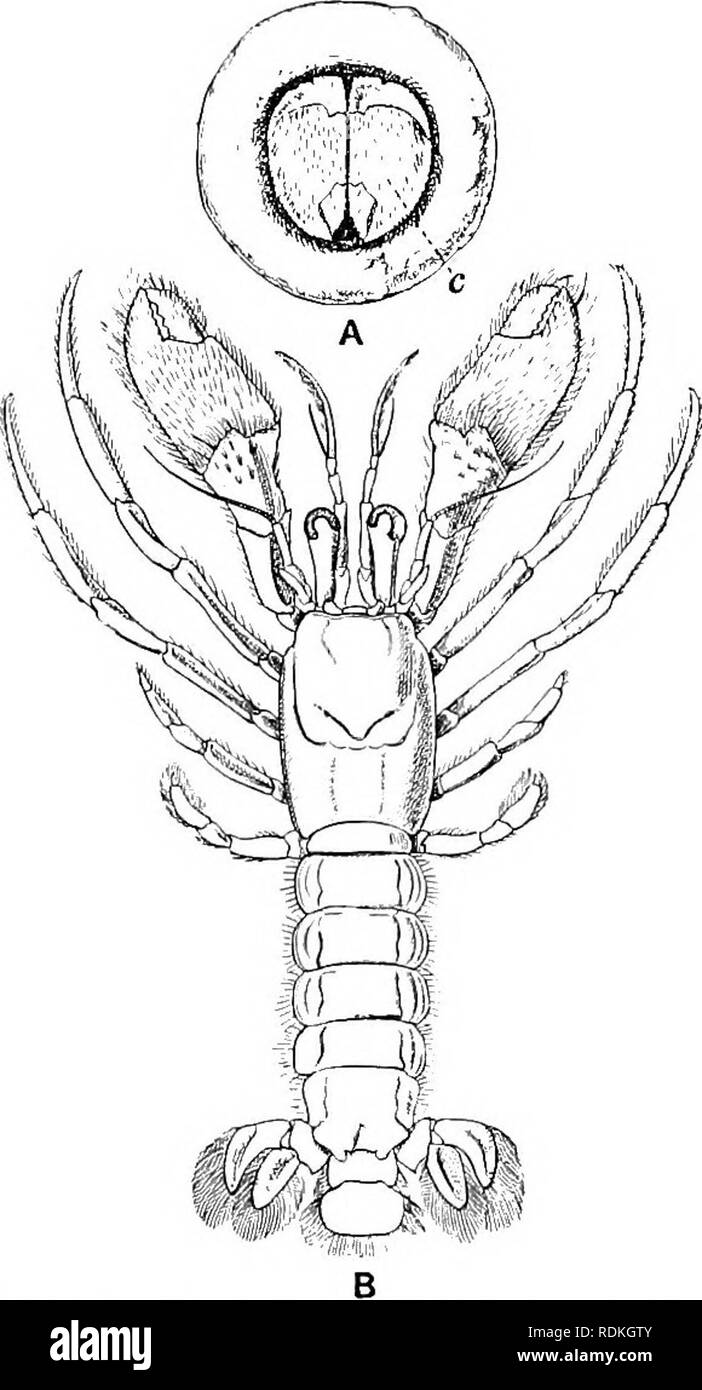. The Cambridge natural history. Zoology. PAGURIDEA—SYMMETRICAL HERMIT-CRABS 173 Besides the ordinary twisted Tagurids which inhabit Gas- teropod shells, there are a few which preserve the symmetry of the body. The interesting Pylocheles miersii ^ (Fig. 118), taken by the Investigator in the Andaman Sea at 185 fathoms, inhabits pieces of bamboo; it is perfectly symmetrical, with well-developed pleopods and symmetrical chelae, which, when the animal is withdrawn, completely shut up the entrance to its house (Fig. 118, A). It is doubtful whether this animal ever inhabited a spiral shell or not i

Image details
Contributor:
The Book Worm / Alamy Stock PhotoImage ID:
RDKGTYFile size:
7.2 MB (273.4 KB Compressed download)Releases:
Model - no | Property - noDo I need a release?Dimensions:
1162 x 2151 px | 19.7 x 36.4 cm | 7.7 x 14.3 inches | 150dpiMore information:
This image is a public domain image, which means either that copyright has expired in the image or the copyright holder has waived their copyright. Alamy charges you a fee for access to the high resolution copy of the image.
This image could have imperfections as it’s either historical or reportage.
. The Cambridge natural history. Zoology. PAGURIDEA—SYMMETRICAL HERMIT-CRABS 173 Besides the ordinary twisted Tagurids which inhabit Gas- teropod shells, there are a few which preserve the symmetry of the body. The interesting Pylocheles miersii ^ (Fig. 118), taken by the Investigator in the Andaman Sea at 185 fathoms, inhabits pieces of bamboo; it is perfectly symmetrical, with well-developed pleopods and symmetrical chelae, which, when the animal is withdrawn, completely shut up the entrance to its house (Fig. 118, A). It is doubtful whether this animal ever inhabited a spiral shell or not in its past history; but there is no doubt that a number of peculiar crabs, which caused the older sys- tematists much trouble, are Pagurids, derived from asym- metrical shell - haunting an- cestors that have secondarily taken to a diiferent mode of life, and lost, or partially lost those characteristics of ordinary Hermit-crabs which are asso- ciated with life in a spiral shell. These are the Lithodidae and the " Eobber - crab, " Birgus latro, of tropical coral islands. Although the Eobber-crab and the Lithodidae bear a certain superficial resemblance to one another in that they lead a free existence, and have reacquired to a great extent their symmetry, yet it is clear that they have been independently derived from different groups of asymmetrical Hermit-crabs, and that their resemblance to one another is clue to convergence. Birgus latro (Fig. 119), a gigantic crab, frequently over a foot in length, lives on land, and inhabits the coasts of coral islands in the Indian and Pacific Oceans where cocoa-nut trees. Fig. 118.—Pylocheles miersii, x 1. A, End view of a piece of mangrove or bamboo, tlie opening of wliich is closed by the great chelae (c) of the Pagurid ; B, the animal removed from its house. (After Alcock.) ' Alcook, loc. cit. ; Borradaile, op. cit. p. 162 ; 1. p.. Please note that these images are extracted from scanned page images that may have been digi